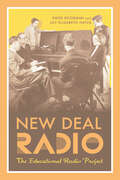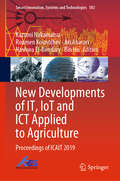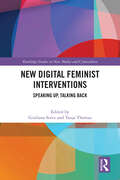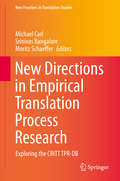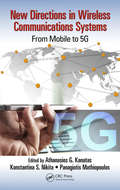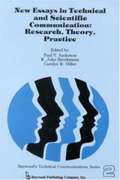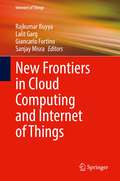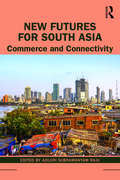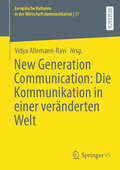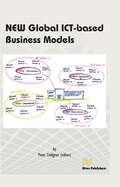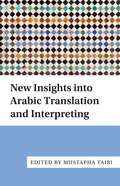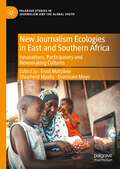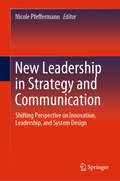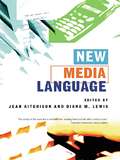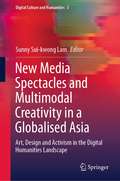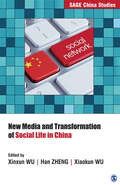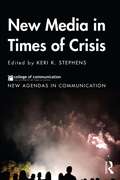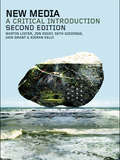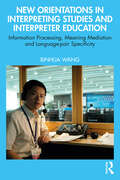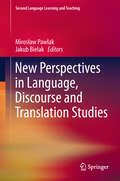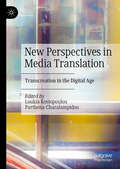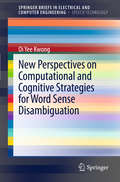- Table View
- List View
New Deal Radio: The Educational Radio Project
by David Goodman Joy Elizabeth HayesNew Deal Radio examines the federal government's involvement in broadcasting during the New Deal period, looking at the U.S. Office of Education's Educational Radio Project. The fact that the United States never developed a national public broadcaster, has remained a central problem of US broadcasting history. Rather than ponder what might have been, authors Joy Hayes and David Goodman look at what did happen. There was in fact a great deal of government involvement in broadcasting in the US before 1945 at local, state, and federal levels. Among the federal agencies on the air were the Department of Agriculture, the National Park Service, the Works Progress Administration (WPA) and the Federal Theatre Project. Contextualizing the different series aired by the Educational Radio Project as part of a unified project about radio and citizenship is crucial to understanding them. New Deal Radio argues that this distinctive government commercial partnership amounted to a critical intervention in US broadcasting and an important chapter in the evolution of public radio in America.
New Developments of IT, IoT and ICT Applied to Agriculture: Proceedings of ICAIT 2019 (Smart Innovation, Systems and Technologies #183)
by Bin Hu Kazumi Nakamatsu Roumen Kountchev Nashwa El-Bendary Ari AharariThe proceedings publishes new research results of scholars from the First International Conference on Agriculture and Information (ICAIT2019) organized by IRNet International Academic Communication Center, held during November 22-24, 2019. The book covers works from active researchers who are working on collaboration of agriculture and various information technologies such as ICT (Information and Communication Technologies) applicable/applied to agricultural produce, manufacturing preservation and distribution of agricultural products, etc. The book focuses on theory, design, development, testing and evaluation of all information technologies applicable/applied to various parts of agriculture and its infrastructure. The topics included are information technologies applicable to smart agriculture, intelligent information systems for smart farm systems, web-based intelligent information systems on agriculture, ICT-based marketing of agricultural products, agricultural product consumption network systems, IoT for agricultural produce and products, soft computing theories, intelligent management for agriculture, data science techniques for agriculture.
New Digital Feminist Interventions: Speaking Up, Talking Back (Routledge Studies in New Media and Cyberculture)
by Tanja Thomas Giuliana SorceThis volume proposes “speaking up” and “talking back” as new theoretical access points for studying feminist activism in digital spaces.Drawing on the influential work of bell hooks, it highlights social justice interventions by feminist/queer/decolonial actors, groups, and collectives who recover the digital as a space for activist organizing and campaigning. In presenting a variety of sociocultural issues, such as gender violence, queer discrimination, or migrant hostility, the book centers empowerment practices in their digital forms, showcasing interventions in Asia, Europe, and the Americas—thereby critically examining the conditions for marginalized voices to speak up, talk back, and be heard in digital publics. In focusing on activist practices, formats, experiences, and scholarship, the contributions analyze many facets of digital feminist contention, including resistance storytelling, hashtag activism, grassroots journalism, or diaspora podcasting.This international and interdisciplinary volume will interest students and scholars of Media and Communication, Social Movements and Activism, Cultural Studies, Gender and Queer Studies, and Race and Ethnicity.
New Directions in Empirical Translation Process Research
by Srinivas Bangalore Michael Carl Moritz SchaefferThis volume provides a comprehensive introduction to the Translation Process Research Database (TPR-DB), which was compiled by the Centre for Research and Innovation in Translation and Technologies (CRITT). The TPR-DB is a unique resource featuring more than 500 hours of recorded translation process data, augmented with over 200 different rich annotations. Twelve chapters describe the diverse research directions this data can support, including the computational, statistical and psycholinguistic modeling of human translation processes. In the first chapters of this book, the reader is introduced to the CRITT TPR-DB. This is followed by two main parts, the first of which focuses on usability issues and details of implementing interactive machine translation. It also discusses the use of external resources and translator-information interaction. The second part addresses the cognitive and statistical modeling of human translation processes, including co-activation at the lexical, syntactic and discourse levels, translation literality, and various annotation schemata for the data.
New Directions in Wireless Communications Systems: From Mobile to 5G
by Athanasios G. Kanatas, Konstantina S. Nikita and Panagiotis MathiopoulosBeyond 2020, wireless communication systems will have to support more than 1,000 times the traffic volume of today's systems. This extremely high traffic load is a major issue faced by 5G designers and researchers. This challenge will be met by a combination of parallel techniques that will use more spectrum more flexibly, realize higher spectral efficiency, and densify cells. Novel techniques and paradigms must be developed to meet these goals. The book addresses diverse key-point issues of next-generation wireless communications systems and identifies promising solutions. The book's core is concentrated to techniques and methods belonging to what is generally called radio access network.
New Directions in the Analysis of Multimodal Discourse
by Wendy L. Bowcher Terry D. RoyceNew Directions in the Analysis of Multimodal Discourse offers a comprehensive international view of multimodal discourse and presents new directions for research and application in this growing field. With contributions from top scholars around the world, this work opens up the field of multimodal discourse analysis as it covers a wide range of interests such as computational linguistics, education, ideology, and media discourse. The range and scope of the chapters in this book provide groundbreaking insights into exploring and accounting for the various facets of multimodality in a range of texts and contexts. Initial chapters specifically aim to tackle theoretical issues, while subsequent chapters focus on important research areas such as writing and graphology, genre, ideology, computational concordancing, literacy, and cross cultural and cross linguistic issues. In the final chapters, an emphasis is placed on the educational implications of multimodality in first and second language contexts, a particularly new and interesting contribution.
New Essays in Technical and Scientific Communication: Research, Theory, Practice
by Paul V. Anderson Carolyn R. Miller R. John BrockmannNew Essays in Technical and Scientific Communication represents the most important collection of writings about technical communications ever compiled. Focusing on a wide range of theoretical and practical issues, these essays reflect the rigor, vitality, and interdisciplinary nature of modern technical communications. This represents a collection of the very best scholarly work being done.
New Forms and Expressions of Conflict at Work
by Gregor GallA survey and analysis of the new forms and expressions of conflict at work under capitalism. This collection uses theoretical and empirical approaches to demonstrate that there is an underlying historical continuity to current and new forms and expressions of conflict at work and that there is also a path dependency by country and culture. Although the strike is in decline in many countries, it is not so in all and different means of expressing and resolving collective grievances are used but not always as substitutes to the weapon of strike.
New Frontiers in Cloud Computing and Internet of Things (Internet of Things)
by Rajkumar Buyya Giancarlo Fortino Sanjay Misra Lalit GargThis book provides an account of the latest developments in IoT and cloud computing, and their practical applications in various industrial, scientific, business, education, and government domains. The book covers the advanced research and state of the art review of the latest developments in IoT and cloud computing and how they might be employed post-COVID era. The book also identifies challenges and their solutions in this era, shaping the direction for future research and offering emerging topics to investigate further. The book serves as a reference for a broader audience such as researchers, application designers, solution architects, teachers, graduate students, enthusiasts, practitioners, IT managers, decision-makers and policymakers. The book editors are pioneers in the fields of IoT and Cloud computing.Provides an account of the latest developments in IoT and cloud computing and how it can aid in a COVID-19 Era in a variety of applications; Identifies IoT and cloud computing challenges and their solutions, shaping the direction for future research; Serves as a reference for researchers, application designers, solution architects, teachers, and graduate students.
New Futures for South Asia: Commerce and Connectivity
by Adluri Subramanyam RajuThis book is a comprehensive examination of the society, polity and economy of South Asian countries and their future trajectories. The chapters included in the volume present key insights into the geopolitical dynamics of the region. New Futures for South Asia: draws on case studies from the region to discuss how democracy has fared in terms of state-society linkages, transformational possibilities and the globalization and radicalization of politics; studies possibilities of economic cooperation in South Asia, including common currency, regional imbalances and aid, transport connectivity and electricity consumption; examines the crucial role of SAARC and bilateralism in forging connectivities across the diverse geographies of the region. A major intervention in re-shaping South Asian studies, this book will be a great resource for scholars and researchers of security studies, strategic affairs, international relations, development studies and politics.
New Generation Communication: Die Kommunikation in einer veränderten Welt (Europäische Kulturen in der Wirtschaftskommunikation #37)
by Vidya Allemann-RaviCommunication of the new generation is upon us. It was not long ago that the idea of remote working or of machine learning seemed like futuristic endeavors. Yet now, the prospect of using various communication technologies to work for us has never been more feasible. We are navigating connected ecosystems and using data technologies and algorithms to keep pace with an ever-shifting business world. This volume focuses on the impact of communication in a changing world on society and business cultures. The issues that are raised by the authors of this volume range from exploring how language and technology interact in the workplace environment to considering the use of generative technologies and artificial intelligence in marketing and advertising. While the authors showcase a diversity of disciplinary and methodological approaches, they are united in their underlying belief that communication in a changing world is, by and large, a facilitator of dialogue, and is powered by interactions and expansive, cross-disciplinary conversations.
New Global Ict-Based Business Models (River Publishers Series In Multi Business Model Innovation, Technologies And Sustainable Business Ser.)
by Peter LindgrenThe New Global Business model (NEWGIBM) book describes the background, theory references, case studies, results and learning imparted by the NEWGIBM project, whichis supported by ICT, to a research group during the period from 2005-2011. The book is a result of the efforts and the collaborative work between SMEs, consultancies and researchers across various lines of business, competences and research domains. The book commences with a theoretical discussion of the business model and its innovationliterature and explains how this was a collaborative study by researchers from three Danish Universities. The book continues by describing, analyzing and showing how NEWGIBM was implemented in SMEs in different industrial companies/networks. Based on this effort, the researchers try to describe and analyze the current context, experience of NEWGIBM and finally the emerging scenarios of NEWGIBM.The NEWGIBM book serves as a part of the final evaluation and documentation of the NEWGIBM project and is supported by results from the following projects: M-commerce, Global Innovation, Global Ebusiness & M-commerce, The Blue Ocean project, International Center for Innovation and Women in Business, NEFFICS, which providedinformation about the innovating business models funded by Ministry of Science and Innovation Denmark, Ministry of Economics Denmark, EU Social Fund, EU KASK program and EU 7 Framework program Internet of Things. This book adds new knowledge to the global business models based on ICT.
New Grad Job Hacks: The Complete Guide to Getting a Job After You Finish College
by Matt TranThe founder of YouTube’s largest career channel, Engineered Truth, provides “practical how-tos on how to navigate life after college” (Tam Pham, bestselling author of How to Network).Just graduated college? Still waiting for the perfect job that was supposed to be dropped in your lap after the graduation ceremony? Wondering when you get to start that marvelous and rewarding career you always dreamed about? New Grad Job Hacks is here to help. Career expert YouTuber and blogger Matt Tran takes you step-by-step through how to make the most of your degree. Tran’s channel, Engineered Truth, has helped thousands of new grads figure out their best paths to fulfilling careers. In New Grad Job Hacks, Tran guides us from job fairs to social media, from internships to job shadowing and teaches how to research companies, interview, negotiate, and get that job offer you always wanted.
New Insights into Arabic Translation and Interpreting
by Mustapha TaibiThis book addresses translation and interpreting with Arabic either as a source or target language. It focuses on new fields of study and professional practice, such as community translation and interpreting, and offers fresh insights into the relationship between culture, translation and interpreting. Chapters discuss issues relating specifically to Arabic and the Arab cultural context and contribute views, research findings and applications that come from a language combination and a cultural background quite different from traditional Eurocentric theoretical and professional positions. This volume is a significant addition to resources on Arabic translation and interpreting and contributes fresh perspectives to translation studies in general. It is of interest to students, researchers and professionals working in public service, community, legal, administrative and healthcare translation and interpreting, as well as intercultural communication and translator education.
New Journalism Ecologies in East and Southern Africa: Innovations, Participatory and Newsmaking Cultures (Palgrave Studies in Journalism and the Global South)
by Dumisani Moyo Shepherd Mpofu Trust MatsileleThis volume presents case studies of news media employing and integrating social media into their news production practices. It links social media use to journalistic practices and news production processes in the digital age of the Global South. Critically, the chapters look at seminal cases of start-up news media whose content is informed by trends in social media, ethical considerations and participatory cultures spurred by the wide use of social media. There has been considerable research looking at the potential of new media technologies, traditional journalism and citizen reporting. The extent to which these new media technologies and ‘citizen journalism’ have morphed or reconfigured traditional journalism practice remains debatable. Currently, there are questions around the limits of social media in journalism practice as the ethical lines continue to become blurred. It is this conundrum of the role of social media in the reconfiguration of the media, news making, production and participatory cultures that requires more investigation. Social media has also turned the logic of the political economy of media production on its head as citizens can now produce, package and distribute news and information with shoestring budgets and in authoritarian regimes with no license of practice. This new political economy means the power that special interest groups used to enjoy is increasingly slipping from their hands as citizens take back the power to appropriate social media journalism to counter hegemonic narratives. Citizens can also perform journalistic roles of investigating and whistleblowing but with a lack off, or limited, regulation. This volume seeks to explore and untangle these issues, and provides an invaluable resource for researchers across the field of journalism, mass media, and communication studies.
New Leadership in Strategy and Communication: Shifting Perspective on Innovation, Leadership, and System Design
by Nicole PfeffermannThis contributed volume provides new approaches, fresh ideas, valuable insights, and latest research in leadership—from strategic business (model) innovation to system design and humanity—and is a knowledge source and inspirational guide for scientists and practitioners alike.A key theme is the provision of an integrated perspective on leadership in strategy and communication which allow (senior) leaders, managing di-rectors, project managers, and individuals to (1) better link strategic busi-ness innovation and leadership and (2) shift to the new human self-lead-ership paradigm and in particularly leadership advances that consider ideas from multiple disciplines and transgenerational views. That includes a new understanding about knowledge, learning and change and how leaders re-discover and develop their human abilities, which include intui-tion/strength, balance and clarity, projection-reflection, and wisdom.This volume also makes an important contribution to the evolving aca-demic domain by providing the latest insights on trauma research, DNA healing, system (re)design, and growth & abundance mindset in the ad-vanced co-creation age.
New Media Language
by Jean Aitchison Diana M. LewisNew Media Language brings leading media figures and scholars together to debate the shifting relations between today's media and contemporary language.From newspapers and television to email, the Internet and text messaging, there are ever increasing media conduits for news. This book investigates how developments in world media have affected, and been affected by, language. Exploring a wide range of topics, from the globalization of communication to the vocabulary of terrorism and the language used in the wake of September 11, New Media Language looks at the important and wide-ranging implications of these changes. From Malcolm Gluck on wine writing, to Naomi Baron on email, the authors provide authoritative and engaging insights into the ways in which language is changing, and in turn, changes us.With a foreword by Simon Jenkins, New Media Language is essential reading for anyone with an interest in today's complex and expanding media.
New Media Spectacles and Multimodal Creativity in a Globalised Asia: Art, Design and Activism in the Digital Humanities Landscape (Digital Culture and Humanities #3)
by Sunny Sui-kwong LamThis edited volume aims to unpack the digitisation of art and media within the dynamics of participatory culture, and how these changes affect the power relations between the production and consumption of these new forms in a globalised Asia. This follows the rise of new art forms and social media platforms in wake of rapid and ongoing digitisation, which has, in turn, produced far-reaching implications for changing media ownership and its role in social, cultural, economic, as well as political activities. New challenges arise every day in relation to digital art and design practices and social media communications, and their respective impact on identity politics. This book showcases a diverse range of interdisciplinary research on these concomitant changes and challenges associated with digital media and technologies within the context of a globalised Asia. The case studies included present perspectives on Asia’s evolving digital humanities landscape from Hong Kong, China, India, Korea and from across Southeast Asia, with topics that tackle organisational digital marketing, brand advertising and design, mobile gaming, interactive art, and the cultural activities of ethnic and sexual minority communities in the region. This book will of interest to scholars in digital humanities focused on new media and cultural studies.
New Media and Transformation of Social Life in China (SAGE China Studies)
by Xinxun Wu Han Zheng Xiaokun WuThe field of media and communication has expanded substantially in China over the last few decades. New Media and the Transformations of Social Life in China covers in detail the main aspects related to media in China, including new media technologies, social networks, media convergence, smart cities, digital media, information and communication technology (ICT), and risk society. A major strength of this book is its coverage of the role of ICT for social participation in urban policy and management areas, which include e-governance, social security, and decision support systems. The book also addresses issues such as the financial crisis, the global energy crisis, and environmental pollution.
New Media in Times of Crisis (New Agendas in Communication Series)
by Keri K. StephensNew Media in Times of Crisis provides an interdisciplinary look at research focused around how people organize during crises. Contributors examine the latest practices for communicating during crises, including evacuation practices, workplace safety challenges, crisis social media usage, and strategies for making emergency alerts on U.S. mobile phones constructive and helpful. The book is grounded in the practices of first responders, crisis communicators, people experiencing tragic events, and communities who organize on- and offline to make sense of their experiences. The authors draw upon a wide range of theories and frameworks with the goal of establishing new directions for research and practice. The text is suitable for advanced students and researchers in crisis, disaster, and emergency communication.
New Media: A Critical Introduction
by Jon Dovey Seth Giddings Iain Grant Kieran Kelly Martin ListerNew Media: A Critical Introduction is a comprehensive introduction to the culture, history, technologies and theories of new media. Written especially for students, the book considers the ways in which 'new media' really are new, assesses the claims that a media and technological revolution has taken place and formulates new ways for media studies to respond to new technologies. The authors introduce a wide variety of topics including: how to define the characteristics of new media; social and political uses of new media and new communications; new media technologies, politics and globalization; everyday life and new media; theories of interactivity, simulation, the new media economy; cybernetics, cyberculture, the history of automata and artificial life. Substantially updated from the first edition to cover recent theoretical developments, approaches and significant technological developments, this is the best and by far the most comprehensive textbook available on this exciting and expanding subject. At www.newmediaintro.com you will find: additional international case studies with online references specially created You Tube videos on machines and digital photography a new ‘Virtual Camera’ case study, with links to short film examples useful links to related websites, resources and research sites further online reading links to specific arguments or discussion topics in the book links to key scholars in the field of new media.
New Orientations in Interpreting Studies and Interpreter Education: Information Processing, Meaning Mediation and Language-pair Specificity
by Binhua WangThis book proposes a multidimensional model that revisits the epistemology of interpreting studies and the distinctive features of interpreting, and outlines three new research orientations.The first considers interpreting as immediate bilingual information processing, the second considers interpreting as meaning mediation in cross-lingual interpersonal communication and cross-sociocultural interaction, and the third looks at language-pair specificity in interpreting. The main research topics, concepts and methods are covered, and case studies and examples are provided. The author also proposes a multicomposite framework of interpreter competence as the conceptual foundation of interpreter education in the AI era, for which three major shifts are identified as necessary, particularly the transition from interpreting skill training to interpreter competence development. The research orientations discussed in this book are important as they shed new light on the nature and mechanism of interpreting, open up new venues for interpreting studies and provide meaningful responses to new issues emerging from changes in the interpreting profession with the development of AI technologies. This is essential reading for all engaged in teaching, researching and studying interpreting and interpreting studies.
New Perspectives in Language, Discourse and Translation Studies
by Mirosław Pawlak Jakub BielakThe current volume is a collection of papers representing the most recent developments in linguistics, specifically in the fields of language, discourse and translation studies. It includes papers representative of traditionally distinguished linguistic subdisciplines such as phonetics and phonology, morphology and syntax, historical linguistics, pragmatics, discourse analysis and sociolinguistics, as well as translation. Since the contributions contained in the book touch upon such a variety of disciplines and do so from both more traditional and more innovative perspectives, it will be an important point of reference for scholars, graduate students and lecturers teaching courses in linguistics.
New Perspectives in Media Translation: Transcreation in the Digital Age
by Loukia Kostopoulou Parthena CharalampidouThis edited book explores the practice of transcreation in a variety of contexts, from audiovisual material to digital and marketing material. Drawing on the latest developments in translation and media studies, the volume promotes an understanding of the transcreation process and the way it challenges the concept of translation (Chaume 2018) and impacts on training for translators, localizers and content creators. Chapters include both theoretical and experimental research contributions that investigate facets of transcreation in diverse media and genres and offer constructive insights in the discipline. This book covers the theoretical aspects and practices of transcreation in audiovisual and digital media and will appeal to scholars, researchers and professionals working in the fields of translation, especially audiovisual translation, transcreation, localization and new media.
New Perspectives on Computational and Cognitive Strategies for Word Sense Disambiguation
by Oi Yee KwongCognitive and Computational Strategies for Word Sense Disambiguation examines cognitive strategies by humans and computational strategies by machines, for WSD in parallel. Focusing on a psychologically valid property of words and senses, author Oi Yee Kwong discusses their concreteness or abstractness and draws on psycholinguistic data to examine the extent to which existing lexical resources resemble the mental lexicon as far as the concreteness distinction is concerned. The text also investigates the contribution of different knowledge sources to WSD in relation to this very intrinsic nature of words and senses.
